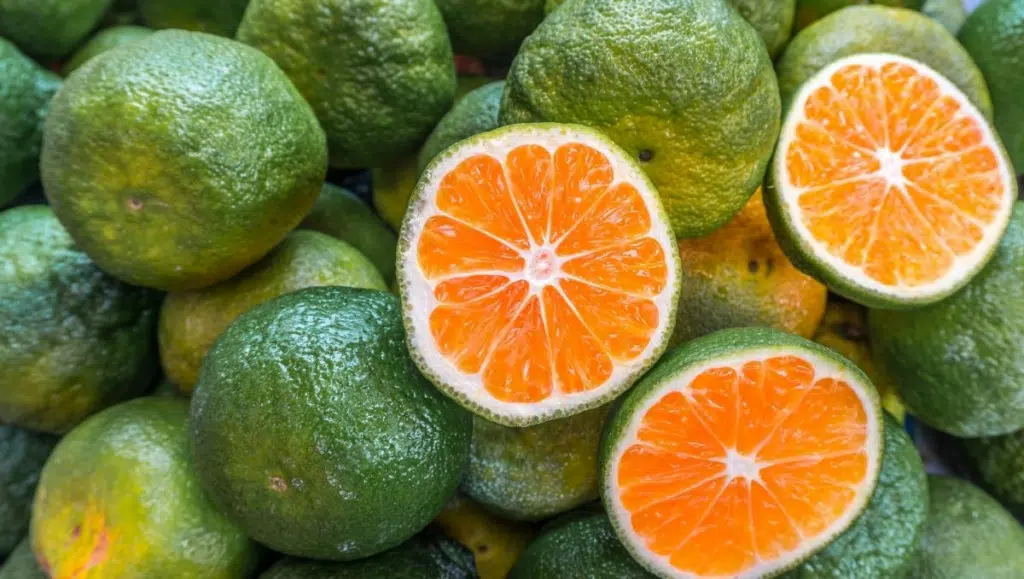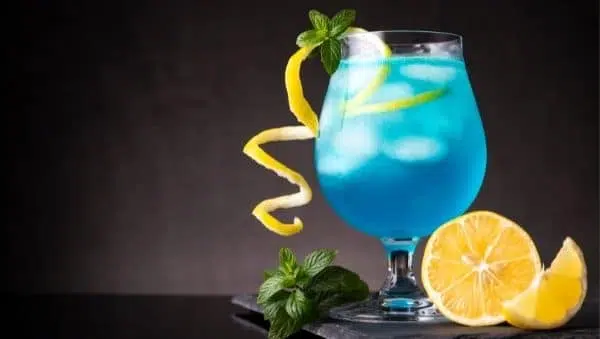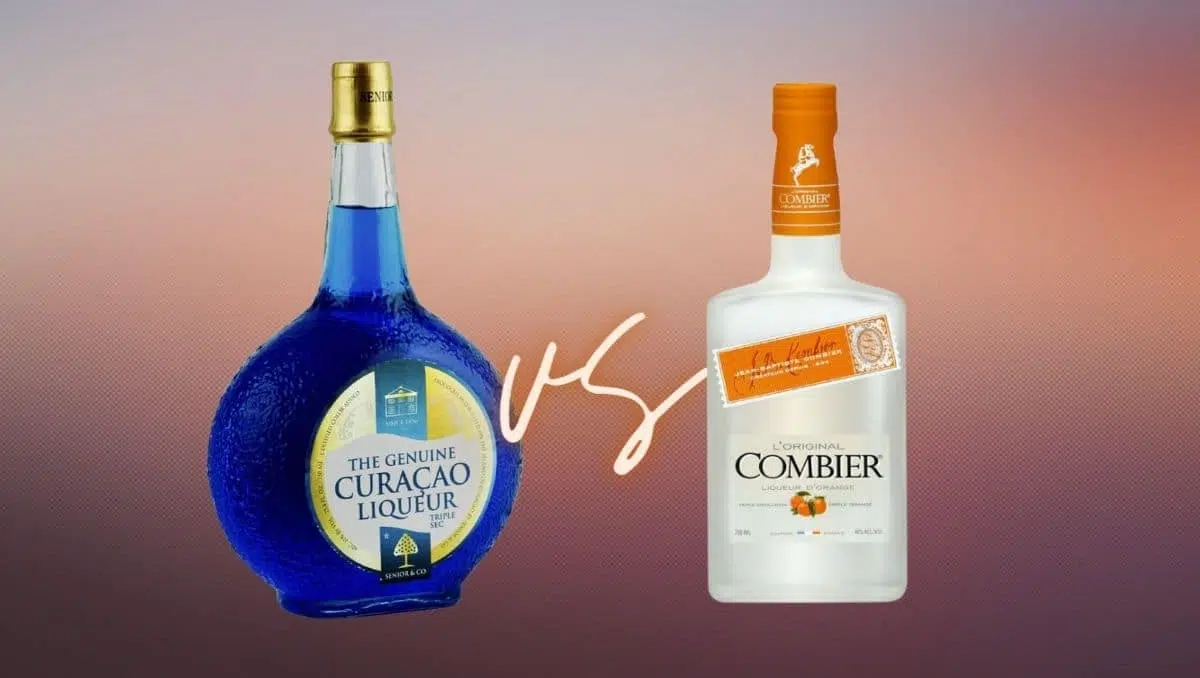The terms Triple Sec, Curaçao, and orange liqueur are often used interchangeably. All three are fruit liqueurs with Orange liqueur describing the general subcategory of sweet liqueurs with orange flavor.
Triple Sec is a generic term for French liqueur boasting a bittersweet orange essence, enjoyed neat or as an ingredient in classic cocktails like Margaritas and Cosmopolitans. Its vibrant citrus flavor comes from distilling green bitter orange peels with a neutral spirit base, resulting in a clear, orange-forward delight often exemplified by renowned brands like Cointreau, Combier, and DeKuyper.
Curaçao is another generic term for orange liqueurs with a distinct bitter orange taste. The liqueur is similar to Triple Sec in appearance and flavor and is a vibrant orange liqueur with an alcohol content of 15 - 40%. Made from Laraha oranges (Citrus aurantium currassuviensis) from Curaçao, this liqueur gained its distinctive slightly bitter taste.
Triple Sec and Curaçao are both ingredients you can find in many cocktail recipes, often as substitutes. However, besides all similarities, the two citrus liqueurs also show significant differences regarding color, history, culture, and usage.
Our thorough comparison covers all the essential information you need to understand the differences between Triple Sec vs. Curacao liqueurs. That includes history, how they are made, taste, appearance, ABV, and the best cocktails to make with them.
What is Triple Sec?

Triple Sec is a generic term for a French liqueur with a distinct bittersweet orange flavor. The liquor is a clear, see-through liquid and usually has an alcohol content of between 20 and 40%, sometimes also a bit lower. As a rule of thumb, the higher the ABV of a Triple Sec, the better the complexity and overall quality. It's occasionally consumed neat but most commonly part of several classic cocktails like Margaritas, Mai Tais, and Cosmos.
The flavor of Triple Sec is very orange-forward and citrusy. Its strong orange aroma comes from the essential oils in the peel of premature oranges.
The base spirit used for Triple Sec usually is derived from sugar beet because it tastes neutral and does not spoil the orange aroma. This base spirit gets infused with the green bitter orange peels. The result is then distilled three times.
Triple Sec was invented in 1834 in the kitchen of distiller Jean-Baptiste Combier and his wife, Josephine. They combined Hawaiian oranges and sweet Valencia oranges, creating a distinct flavor through their three-step distillation method.
This triple distillation, most likely, is also the reason for the name of the liqueur: Triple Sec - three times dry. It once was a quality indication rather than a product name.
Cointreau is by far the most famous Triple Sec brand. Other notable brands producing the orange liqueur are Combier, DeKuyper, and Bols.
What is Curaçao?

Regarding appearance and taste, Curaçao is very similar to Triple Sec. It also is an orange liqueur with an ABV of 15 - 40%. It comes in many different (artificial) colors, but it's mainly known to be blue - Blue Curaçao. In fact, Curaçao is the forerunner of Triple Sec.
To make Curaçao, one uses the peels of oranges, just like with its French relative. However, the oranges used to make Curaçao are of a very particular variety: the Laraha orange growing on the Dutch ABC (Aruba, Bonaire, and Curaçao) islands in the Caribbean.
In the early 16th century, the Dutch brought the Seville orange to Curaçao Island (the C in ABC). They wanted to grow them there and profit from the sunny climate. The Dutch West Indies Company even monopolized the island’s resources for spices.
However, the sun was too intense, and the oranges turned bitter and inedible. But the skins of the fruit were very aromatic. One thing led to another, and the result was Curaçao, a slightly bitter orange liqueur produced in the Netherlands.
There's an ongoing discussion about whether Triple Sec and Curaçao are the same. Yet both liqueurs differ in history, ingredients, color, and taste.
Today, it's no longer required that Curaçao liqueur is produced on the island. Therefore many brands make the liqueur in other parts of the world, using other ingredients. Only one distiller remains who still produces Curaçao according to the traditional recipe using original Laraha oranges (curacao oranges).
One popular variation of Curacao is Dry Curacao which is less sweet than the standard liqueur, offering a deeper orange taste and a dry finish.
Triple Sec vs. Curaçao: Detailed Comparison
There's no official or legal definition of the two, and sometimes there are even products that proclaim to be both, Triple Sec and Curaçao. - Pierre Ferrand Dry Curaçao would be one example.
Still, there are significant factors that serve as a general distinction when comparing Triple Sec and Curaçao. Let's start with their differences in history and origin.
| Aspect | Triple Sec | Curaçao |
|---|---|---|
| Origin | Thought to originate in Saumur, France, crafted by Jean-Baptiste Combier and his wife Josephine as a drier version of Curaçao. | Emerging in the 1600s as the Dutch West Indies Company brought Seville oranges to Curaçao, resulting in the distinctive Laraha orange and the creation of Curaçao liqueur. |
| Taste & Aroma | Tangy, dry, and clean on the palate with slight variations. Notably drier and cleaner in taste. | Tangy, tart, with pronounced sweetness and bitterness. Slightly sweeter and more bitter in taste. |
| Appearance | Primarily colorless and clear. | Comes in various colors, including the iconic Blue Curaçao. |
| ABV | Typically ranges from 20% to 40%, often at 40% for established brands like Combier and Cointreau. | Typically ranges from 15% to 40%, usually below 28% for popular brands like Bols, Drillaud, and DeKuyper's Blue Curaçao. |
| Production Methods | Based on sugar beet; infused with orange peels, triple-distilled. | Based on sugar cane; infused with Laraha orange peels from Curaçao, traditionally produced by Señor & Co. |
| How to Drink | Often consumed neat, chilled, or in cocktails like Margarita, Cosmopolitan, Long Island Iced Tea, and Sidecar. | Not typically served neat; used in cocktails like Blue Hawaii, Mai Tai, Blue Lagoon, and Adios Motherf*cker. |
| Non-Drink Use Cases | Used for cooking and desserts. | Also used in cooking and dessert-making. |
| Notable Brands | Cointreau, Combier, DeKuyper, Bols. | Senior & Co, Pierre Ferrand, Giffard, DeKuyper, Vedrenne. |
| Substitutes | Can be substituted with Curaçao; Grand Marnier is another option. | Can be substituted with Triple Sec; Grand Marnier is an alternative. |
Origin
Curaçao is believed to be among the earliest orange liqueurs. As the Dutch West Indies Company took control of Curaçao in 1634, the liqueur made from laraha oranges emerged. The blue version of Curaçao was most likely first produced by Lucas Bols. He created Crème de Ciel, a blue Curacao made with sweet orange peels.
Around 1896, Senior & Co. began producing and selling Curaçao on the island. Until today, they're the only distiller to produce authentic Curaçao.
Conversely, Triple Sec's origins are thought to trace back to Saumur, France, where Jean-Baptiste Combier and his wife Josephine crafted an orange-flavored liqueur reminiscent of Curaçao but designed to be less sweet, hence its moniker "sec" or "dry."
In 1875, the Cointreau company formulated its rendition and introduced it at the Exposition Universelle of 1878, gaining significant popularity and ultimately becoming the most famous Triple Sec today.
Taste & Aroma
The different ingredients in Triple Sec and Curacao lead to slight variations in taste and smell. Both liqueurs have a very fragrant aroma and a distinct orange note.
Both types of orange liqueur usually work with a neutral base spirit to ensure the orange flavor shines: Triple Sec often with sugar beet, native to Europe, while Curaçao is typically based on sugar cane, growing in the Caribbean region.
Overall, both types of liqueurs have a tangy, tart, dry, and somewhat sharp taste. However, Curaçao has a more pronounced sweetness and bitterness. Triple Sec, on the other side, has a cleaner palate and is significantly drier.
Some consider the taste of both liqueurs identical and claim that the term sec for dry is nothing more than a marketing gag. Yet, when tasting them side by side, you can clearly detect the differences.
Appearance
Triple Sec usually is see-through, while Curaçao is mostly sold as colored versions (blue and orange). Even the market leader in the Triple Sec category, Cointreau, is colorless despite many thinking otherwise due to the iconic orange-colored bottle.
Curaçao, in turn, is best known for its vibrant blue version, Blue Curaçao. Dry Curaçao usually has an orange shade - some more intense, some less. Rarely do you come across a colorless Curaçao, too, but that's truly an exception.
ABV
There's no set ABV for either Curaçao or Triple Sec. Also, the typical range for both is similar, with 15- 40% for Curaçao and 20 - 40% for Triple Sec.
However, many established producers of Triple Sec can are at the upper end of the scale. For instance, Combier, Cointreau, and the closely related Grand Marnier all have an alcohol content of 40%.
Popular Curaçao brands, in turn, usually clocking in somewhere below 28% vol. If you take, for example, Bols, Drillaud, or DeKuyper's Blue Curaçao, you will find them between 15 and 27% ABV.
Production methods
Triple Sec and Curaçao are produced with a neutral spirit base that gets infused with the peels from oranges.
Originally, Curaçao was produced only from the Laraha oranges growing on the island of Curaçao. But only Señor & Co., located in Curaçao, is still doing that.
These days the Seville orange and several other varieties are used for both types of orange liqueurs. Their peels are soaked in alcohol and then get distilled to concentrate the flavors.
By the way, Señor & Co. is one of the brands selling their product as Curaçao/Triple Sec and has an ABV of 40%.
Regarding the distillation, there's also no general rule. However, top-shelf Triple Sec brands still triple-distill their product, as the name suggests.
How to drink
Triple Sec initially was a digestif and meant to be served after a meal. Even today, it's still commonly consumed neat or chilled. Curaçao, on the other hand, is not a liqueur you would serve neat or on the rocks.
Curacao and Triple Sec both work excellently as fruity components in cocktails based on rum, tequila, and gin.
Cocktails
Triple Sec is the main ingredient in many classic cocktails. The bright citrus liqueur is often paired with ingredients that work well with a crisp orange flavor. Popular Triple Sec cocktails include the Margarita, Cosmopolitan, Long Island Iced Tea, Between the Sheets, and Sidecar.
On the other hand, Curacao is often used to make tropical mixed drinks. Some of the most popular curaçao cocktails are the Blue Hawaii, Mai Tai, Blue Lagoon, and Adios Motherf*cker.
Both orange liqueurs are essential cocktail ingredients in the world of mixology.
Non-Drink use cases
Like many other spirits and liqueurs, Curaçao and Triple Sec have alternative uses. For once, you can use stronger, higher-proof bottles as antiseptics in an emergency. However, they both are better when used for cooking or making desserts.
Even classic desserts like Crêpes Suzette use a Triple Sec like Cointreau to bring a complex orange taste to the dish. Other dessert ideas are stuffed French Toast or Mango Flambe.
Notable brands
There are major brands producing each of these orange liqueurs. For Curaçao, the most prominent brands are Senior & Co distillery, Pierre Ferrand, Giffard, DeKuyper, and Vedrenne.
Cointreau is by far the most famous Triple Sec brand. Other notable brands producing the orange liqueur are Combier, DeKuyper, and Bols.
Substitutes
People sometimes wonder if the two liqueurs can be used as a substitute for one another. And since both are citric, orange-flavored liqueurs, you can do that. Just be aware that the difference is palpable and also visible.
Another option that works as a substitute for both is Grand Marnier. This orange liqueur is similar to Triple Sec but has a brandy base as it's based on a blend of cognac that gives the resulting liqueur a richer taste.
Cocktails with Curaçao

Curaçao is typical for tropical drinks and Tiki cocktails. Popular cocktail recipes that ask for (Blue) Curaçao are usually of the tropical kind. The list includes:
- Blue Lagoon: A simple recipe consisting of Curacao liqueur, vodka, and lemonade.
- Blue Hawaiian: A complex drink based on vodka and rum, sweetened with blue curaçao and simple syrup.
- Swimming Pool: A sweet tropical cocktail based on rum, vodka, pineapple juice, coconut cream, heavy cream, and topped with curaçao.
- Mai Tai: A famous tiki cocktail made with two types of rum. The Mai Tai recipe uses curaçao to bring complexity and a bright orange flavor into the drink.
- Curacao Rum Runner: Dry Curaçao is used in this twist on the classic Rum Runner cocktail.
And Blue Curaçao is also the go-to choice for the blue part when making Rainbow shots. In general, it's safe to say that nearly always you see bright blue in a drink, Blue Curaçao is involved.
Popular Cocktails with Triple Sec
Triple Sec is a main ingredient in several classic cocktail recipes. The list includes:
- Cosmopolitan: A 90s cocktail made with vodka, cranberry juice, fresh lime, and triple sec.
- Classic Margarita: Probably the most popular tequila cocktail uses fresh lime juice and Triple Sec to balance the alcoholic notes from the agave spirit.
- Long Island Iced Tea: This boozy drink is a concoction of five different liquors, one of them being Triple Sec. The other ingredients are lemon juice, syrup, and cola.
- Triple Sec Mimosa: This twist on a classic Mimosa adds orange liqueur to the two base ingredients of orange juice and sparkling wine.
- Lynchburg Lemonade: Developed by Tony Mason, Lynchburg Lemonade is a popular whiskey cocktail based on Jack Daniel's.
Further Triple Sec cocktails are Spicy Grapefruit Margaritas or refreshing Coconut Margaritas.

